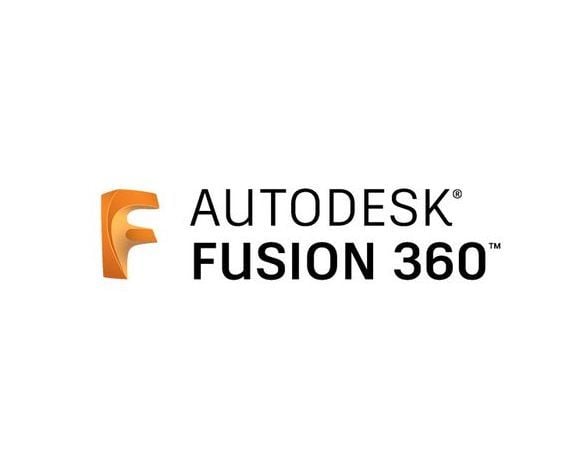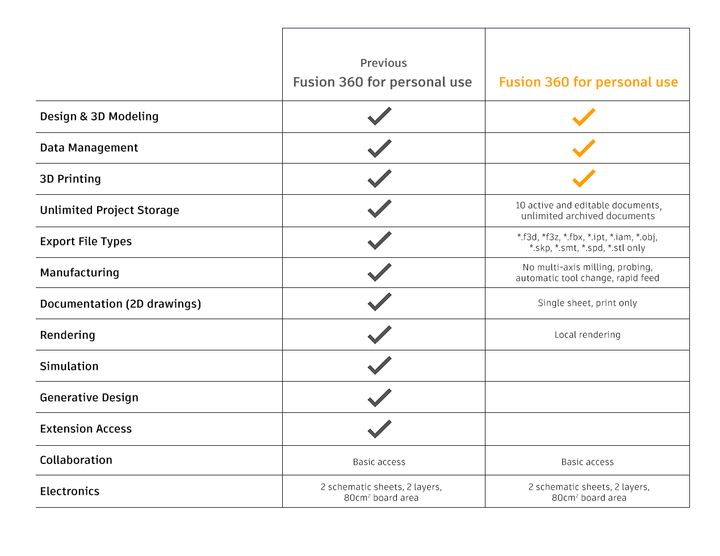
Autodesk abruptly announced some significant changes in the functionality of the free version of Fusion 360, their flagship 3D design tool.
The subscription-based Fusion 360 tool is extremely popular due to its unique combination of broad 3D functionality and relatively low price, as compared to other professional 3D software packages.
Fusion 360 For Personal Use
That popularity rose to another level when Autodesk offered a free tier, called “Fusion 360 For Personal Use”, where almost anyone could use a somewhat restricted version of the powerful 3D design tool. There are plenty of low-cost or even free 3D design tools, but few are as accessible as Fusion 360, which provides an easy-to-use interface and plenty of online tutorials to help you get going. There’s also a large online community providing answers to common questions.
Fusion 360 For Personal Use is offered on annual basis to qualifying individuals. “Qualifying” means an individual is using the tool for non-profit, personal use, and you must apply to be accepted into the program, and re-qualify annually.
This program was well received by many hobbyist makers and those who inhabit makerspaces worldwide. It’s very common to see someone using Fusion 360 to design gadgets or other items in these environments. Alternatively, few use SOLIDWORKS due to its tremendous costs, and the free, open source tool Blender is not as popular as you might think either, as its design doesn’t provide as easy a means to design mechanical parts.
Fusion 360 For Personal Use Changes

Now Autodesk has announced, and sent notice to current free tier Fusion 360 users about, changes to come to that tier’s functionality, and they come into effect on October 1st, only a few days away. Specifically, only the following functionality will be available in the free tier:
- Design – Standard design and 3D modeling tools
- Electronics – 2 schematics, 2 layers, 80cm2 board area
- Manufacturing – 2.5 axis milling & 3 axis milling, turning, FFF additive, fabrication
- Local Rendering
- Local File Export – STL, OBJ, F3D, F3Z, IPT, FBX, SMT, SKP, DXF-(from sketch)*
- File Import – Standard file types
- Cloud Storage – Maximum of 10 active documents
- Collaboration – Basic Access
- Drawings – Single sheet, print only
Autodesk also says free tier users will be able to download files in IGES, SAT, STEP format until January 19th, 2021.
The features being dropped from the free tier are:
- Probing, 3 + 2-axis milling (tool orientation), multi-axis milling, rapid moves, automatic tool changes
- Multi-sheets, smart templates, output options for drawings (print only).
- Download options from public share links
- Cloud rendering
- Export options including F3Z, DWG, DXF, IGES, SAT, and STEP
- Simulation and generative design
- Unlimited active and editable Fusion 360 documents (10 doc limit).
- Fusion 360 extensions
Analyzing Fusion 360 For Personal Use Limitations
There’s plenty of chatter on the internets about this, suggesting that Autodesk is putting a squeeze on users, and in many respects they are doing so. Let’s look at this objectively and see what’s really going on.
Autodesk Fusion 360 is an extremely powerful product, with probably thousands of features. It performs work in multiple domains and disciplines, and it is extremely unlikely there is anyone who uses literally all of the product’s numerous features. Think of Fusion 360 as a massive pile of features.
On the other hand, users are a very non-homogeneous group. There are definitely power users who frequently use some — but not all — of Fusion 360’s advanced features. There are also very basic users performing the simplest design tasks in the tool. In reality, the set of Fusion 360 users could be arranged on a very wide spectrum, from basic to advanced levels.
The free tier essentially splits that massive pile of features into two categories. One is accessible by Fusion 360 For Personal Use subscribers, and both categories are accessible to paid Fusion 360 clients. The question is, does the new definition of free tier functions match your specific requirements?
Autodesk has defined this “boundary” no doubt by envisioning the type of user they expect to be using the free tier, which seems to be someone using basic functionality to produce a small number of projects. That is not totally unreasonable.
On the other hand, individual users may “get caught” as Autodesk has abruptly shifted the position of the line. It may be that a few of the features being used by some more advanced free tier users are suddenly on the other side of the tracks, and are now inaccessible without a subscription.
I believe Autodesk suspects there are a portion of the free tier users who are actively using the tool for commercial purposes, and I don’t doubt this. They say:
“In order for us to lead the market as the #1 unified tool-of-choice in professional product development and manufacturing, we need to eliminate both the confusion and the misuse that exists within our offerings. We need to make sure that we can scale in a sustainable way and support advanced capabilities for our professional subscribers, while, at the same time, staying true to our guiding principles of democratizing design for everyone. With this in mind, we will be defining clearer lines between what is available for Fusion 360 for personal use versus the other offerings.”
It seems they believe the new limitations will most likely affect those who are using Fusion 360 in an intense manner, well beyond that intended for hobbyists.
Should I Use Fusion 360?
For many hobbyist 3D printer operators, I still think the free tier is quite usable. You can fully design in 3D any object using the complete tool set, and you can export the result in either .STL or .OBJ formats for slicing and 3D printing. That’s plenty to do many projects.
Sure, they’ve dropped a number of features from the free tier, but some, like Simulation and Generative Design, are clearly advanced items that probably should be paid options.
The ominous new limitation might be the “Maximum of 10 active documents”. Some people may think this means they can only design 10 items and then it’s all over for Fusion 360. That’s not the case at all. The key here is in the word “active”. There are now 10 slots for active documents, but you still can store an unlimited number of archived documents. Any archived document can be reactivated at any time by archiving one of the 10 slots. They say:
“Today all your designs and documents are active by default. You can open any design no matter how old or new and they will open. You can have as many document tabs as possible. 10 active documents means that you have 10 spots for any document to open and be editable at any give time. All your other documents will be stored in your projects in a new archived state. They will remain yours, saved in your projects. You can have unlimited number of archived documents (designs) as well as projects (top level folders in your data panel) in your account. If you are at your 10 document capacity, and at any point you want to revisit an older design and open it up, you can do so by archiving an existing active document and activating the archived one to swap places.”
In the non-3D printing functions, the new restrictions are similar. For example, you can do 3-axis machining, but not 5-axis. 5-axis machining is a pretty advanced technique and there are few hobbyists that would even have access to such machines. It seems that Autodesk has spent time analyzing what effects will actually occur with these changes:
“We spent considerable time studying usage patterns and doing interviews with a wide variety of hobbyists, with an end goal to have as little disruption as possible to the vast majority of the hobbyist community. With these changes, you’ll still be able to use Fusion 360 as an end-to-end design solution, from exploring design concepts to 3D printing and additive/subtractive manufacturing. We’ll also continue to support Fusion 360 for personal use with regular product updates, just like how we are supporting it today.”
While this change will likely generate a ton of negative comments from the community, as indeed functionality is truly being lost by free tier users, it may actually be still quite usable for the majority of free tier users. To free tier users, I suggest you give it a try and see if it still meets your needs, and it likely will.
And by the most amazing coincidence, Autodesk is simultaneously having a subscription sale on Fusion 360, with a 40% off discount until October 16th. It seems that you can obtain full access to Fusion 360 for US$297 per year, or under US$25 per month.
That’s likely more than a hobbyist would care to pay, but it is still extremely low for anyone performing commercial work with an advanced 3D design tool, as competitive products are priced sometimes in the tens of thousands.
I encourage you to keep using the Fusion 360’s free tier, as you will likely find that it still does what you need it to do, albeit with a bit of file juggling due to the ten document limit. That’s a small price to pay for access to a powerful 3D tool that’s provided at no charge.
But on the very slight chance that you really do need the full version of Autodesk Fusion 360 and intend on purchasing a subscription, we would really appreciate if you signed up using our affiliate link here, as it helps us pay the bills. I’m a paying subscriber, and it’s a terrific 3D tool.
For those of you who haven’t tried Autodesk Fusion 360, you should definitely take a look at the free tier, even with the new restrictions. You might like it.
Via Autodesk

Got the popup TODAY: “Changes to Fusion 360 … functionality previously available will be limited”
More here: https://www.reddit.com/r/Fusion360/comments/j0poir/they_really_did_it_the_old_scum_move_of_first/